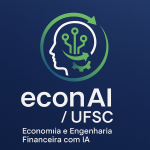Institutional Presentation – English Version
Presentation
The IAEC’s Artificial Intelligence in Financial Economy aims to investigate tools that accelerate the transition to a more efficient and sustainable financial economy through strategies that develop innovative financial solutions supported by multidisciplinary knowledge, new business models, creativity, and computational tools.
The application of AI in the financial economy can enhance and accelerate the development of new financial products, components, and materials through AI-assisted design processes that allow the reuse, recovery, or recycling of existing materials and products, extending their life cycle and creating financial value. It promotes the coordination of production and consumption systems in closed loops powered by renewable sources, reducing waste and making smart use of resources.
It is clear that we need new approaches and solutions that place us on a path of accelerated transition from a linear model to a more efficient and sustainable financial economy. To perform the complex task of redesigning fundamental aspects of our economy, new technologies are needed, including easier and more agile learning processes such as the use of Artificial Intelligence in the financial economy.
Research Lines
Line 1 – Artificial Intelligence and Machine Learning for Financial Applications: This line focuses on using artificial intelligence techniques for forecasting, pricing, and analyzing financial assets based on historical and real-time data, allowing for smarter resource management aligned with sustainability principles.
Line 2 – Development of Circular Financial Products, Components, and Materials: This line aims to develop new financial products, components, and materials through machine learning-assisted circular datasets. This enables rapid prototyping and testing of financial models in an efficient manner, focusing on maximizing resource use and creating more sustainable products in the long run.
Line 3 – Circular Business Models for Financial Systems: The goal of this line is to develop circular business models for the financial sector, using artificial intelligence to combine historical and real-time circular datasets of products and customers. This can increase the circulation of financial products and the use of assets through demand pricing, predictive maintenance, and intelligent inventory management. Additionally, this line proposes an innovation strategy integrated with the sustainable financial economy.
Line 4 – Financial Infrastructure Optimization: This line focuses on developing and improving reverse logistics and sustainable financial infrastructure through a set of circular data needed to close the loop of financial products and materials. This includes improving processes for classification, disassembly, remanufacturing of components, and material recycling, creating a more efficient and sustainable financial cycle.






